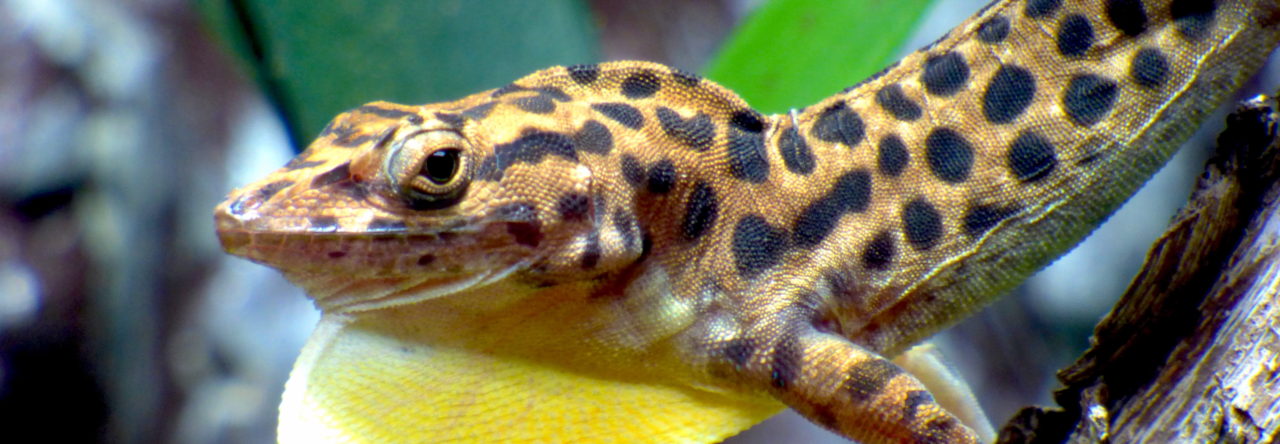Now that’s a dewlap! Photo by Niranjan Sant
All of us that observe and study Anolis (and Sitana) know that dewlaps make our favourite lizards special. Dewlaps can be key for species identification, and we pay a lot of attention to variation in their size and colour. But what exactly constitutes a dewlap?
I’m currently compiling a list of all lizard species with dewlaps, and have run into the problem of how to define a dewlap. Our trusted friend Wikipedia defines a dewlap thus: a longitudinal flap of skin that hangs beneath the lower jaw or neck of many vertebrates. Helpful, perhaps, but only slightly, as the difference between a small dewlap and a puffed-out throat is not always obvious.
So we’re turning to you, dear reader, to help us figure out what a dewlap is. I think the easiest way to do so is by showing you a number of pictures of lizards and asking you to deliver a verdict on whether these lizards are in fact dewlapped (photos from various internet sources). Feel free to offer an alternative definition also, if you’d like.
1. Rock Agama
2. Calotes calotes from Sri Lanka
3. Panther chameleon
4. Varanus griseus
5. Iguana iguana
- Field Assistant Needed for Anolis Research in Florida! - March 4, 2020
- Are Brown Anoles in Florida Really Driving Green Anoles to Extinction III: A Post-Irma Update - September 15, 2017
- Evolution 2017: Spatial Structuring of Urban Green Anoles - June 30, 2017






Skip Lazell
I did not get a photo of #5, but that’s OK, I know the species well. All but Varanus have “dewlaps” but I would use the term “throatfan” for Anoles and others that actually extend and fan their dewlaps.
Larc M
I think they are first and foremost a display mechanism. Reptiles are hot air first, serious bites later. Ritual is very important with these creatures and the dewlap is a major factor in this. The anolis spectrum use their often brightly colored and large ( some even extend down to the chest ) as signals to each other and other animals. It makes the animal look bigger and more threatening. The varanus spectrum use their dewlaps in a similar way, however the look is more like a sac of hot air rather than a brightly colored fan. Unlike iguanas, I don’t believe that either anolis or varanus use their dewlaps for thermoregulation.
Rich Glor
Perhaps a mechanistic definition would help? Can those species that extend their dewlap using the hyoid be easily distinguished from those with more passive dangling dewlaps and those species that inflate their throats with air.
Ambika Kamath
I agree that a mechanistic definition might be ideal, but it could be difficult to tell the role of the hyoid from photos. Would you concur that the Rock Agama above does not have a hyoid in action, whereas the Calotes does?
Kevin de Queiroz
Of the five, I consider only the Iguana to have a dewlap, though the Panther Chamaeleon is perhaps close. As someone who has worked on both iguanas and anoles, I distinguish between pendulous (non-extensible) and extensible dewlaps. I consider it a dewlap when there is basically nothing but skin (well, maybe some connective tissue and muscles that are associated with the skin), as opposed to throat muscles, pharynx, esophagus, etc., between the layers of skin on each side. Both kinds of dewlaps may incorporate components of the hyoid apparatus (but I wouldn’t consider that part of the definition).
James Stroud
Don’t forget other agamids like Otocryptis spp. – incredible dewlaps!
Ambika Kamath
Yes, it’s a given in my mind that Sitana+Otocryptis have the coolest dewlaps of all 🙂 The two are thought to be sister groups, though I don’t think anyone has looked yet at the species-level relationships within the clade (relationships and species number within Sitana are being determined currently). That would shed insight into the evolution of three interesting traits: the dewlap, present in all Sitana and all but one species of Otocryptis, the loss of the external ear in all Otocryptis, and the loss of the last toe on the hind foot in all Sitana.